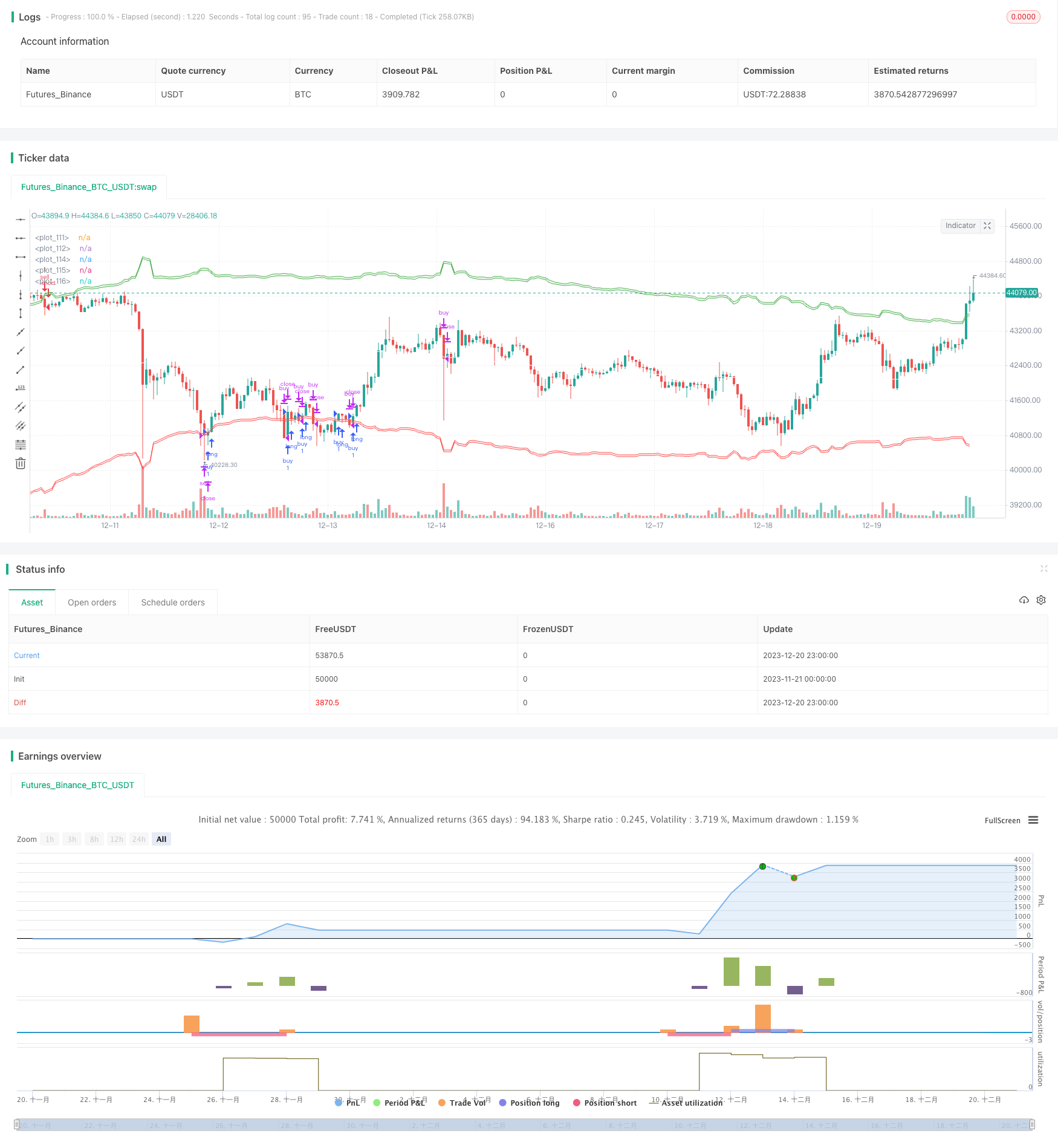
概述
本策略是一个利用相对强度指数(RSI)和交易量的组合指标,来识别趋势方向并进行趋势跟踪的策略。关键点有:
- 使用加权移动平均线计算中轴线,结合交易量信息来判断趋势中轴
- 基于中轴线设定买入区、卖出区
- 使用RSI信息来调整买入区和卖出区的范围
- 进入买入区后设置止损线和止盈线
- 具有重新入场机制
策略原理
本策略使用以下指标和参数:
- 中轴线:计算一定周期内的最高价和最低价的加权移动平均线,使用交易量作为权重,判断趋势的中轴方向
- RSI:计算一定周期内的相对强度指数,将其转化为0-1区间的数值
- 买入区:中轴线加上一定比例的RSI调整量,进入买入区后可做多
- 卖出区:中轴线减去一定比例的RSI调整量,进入卖出区后可做空
- 止盈线:中轴线
- 止损线:买入区下方/卖出区上方一定百分比设置
当价格进入买入区或卖出区后,进行对应方向的开仓操作。之后设定止盈和止损位置,当触发止盈或止损时平仓。同时设置了重新入场机制,如果配置允许,当再次触发开仓信号时可以再次入场。
策略优势
本策略具有以下优点:
- 使用RSI和交易量双重指标识别趋势,提高判断准确性
- RSI参数化调整买入区和卖出区范围,使其更加符合实际趋势
- 交易量信息赋予价格变动更高权重,使中轴线更准确
- 具有止损机制来控制风险
- 可重新入场,降低假突破带来的风险
风险分析
本策略也存在一些风险:
- RSI和交易量参数设置不当可能影响买卖区范围判定的准确性
- 中轴线无法完全准确判断趋势,可能出现错误突破的情况
- 止损点设置过宽可能带来更高损失
- 重新入场机制可能导致过度交易
对应优化措施:
- 调整RSI周期、交易量周期参数使其更符合市场情况
- 结合其它指标验证买卖信号,避免错误突破
- 适当收紧止损点,控制单笔损失
- 限制每日交易次数,避免过度交易
策略优化方向
本策略可从以下方面进行优化:
- 尝试其它指标验证买卖信号,如K线形态、波动率指标等
- 增加仓位管理机制,如盈利后加仓等
- 增加机器学习算法判断趋势准确性,提高买卖区设置的准确度
- 评估止盈止损点设置最优参数
- 不同品种参数不一样,需要单独测试优化
总结
本策略整体来说是一个利用RSI和交易量指标进行趋势跟踪的量化策略。它有着识别趋势信号的双重验证机制,并设置了止盈止损来控制风险,以及重新入场机制来提高获利机会。通过参数调整和算法优化,本策略可以成为一个非常实用的趋势跟踪交易策略。
策略源码
/*backtest
start: 2023-11-21 00:00:00
end: 2023-12-21 00:00:00
period: 1h
basePeriod: 15m
exchanges: [{"eid":"Futures_Binance","currency":"BTC_USDT"}]
*/
// This source code is subject to the terms of the Mozilla Public License 2.0 at https://mozilla.org/MPL/2.0/
// @@@@@@@@@@@@@@@@@@@@@@@@@@@@@@@@@@@@@@@@@@@@@@@@@@@@@@@@@@@@@@@@@@@@@@@@@@@@@@@@
// @@@@@@@@@@@@@@@@@@@@@@@@@@@@@@@@@@@@@@@@@@@@@@@@ @@@@@@@@@@@@@@@@@@@@@@@@@@@@@@@
// @@@@@@@@@@@@@@@@@@@@@@@@@@@@@@@@@@@@@@@@@@@@@@@@@@@@ ,@@@@@@@@@@@@@@@@@@@@@@@
// @@@@@@@@@@@@@@@@@@@@@@@@@@@@@@@@@@@@@@@@@@@@@@@@@@@@@@@ @@@@@@@@@@@@@@@@@@@
// @@@@@@@@@@@@@@@@@@@@@@@@@@@@@@@@@@@@@@@@@@@@@@@@@@@@@@@@@ @@@@@@@@@@@@@@@
// @@@@@@@@@@@@@@@@@@@@@@@@@@@@@@@@@@@@@@@@@@@@@@@@@@@@@@@@@@ @@@@@@@@@@@@@
// @@@@@@@@@@@@@@@@@@@@@@@@@@@@@@@@@@@@@@@@@@@@@@@@@@@@@@@@@@@ @@@@@@@@@@
// @@@@@@@@@@@@@@@@@@@@@@@@@@@@@@@@@@@@ .@@@@@@@@@@@@@@@ @@@@@@@@
// @@@@@@@@@@@@@@@@@@@@@@@@@@@@@@@@@@@ *@@@@@@@@@@@@@@ @@@@@@@
// @@@@@@@@@@@@@@@@@@@@@@@@@@@@@@@@@@@@ @@@@@@@@@@@@@@@ @@@@@
// @@@@@@@@@@@@@@@@@@@@@@@@@@@@@@@@@@@@@@ @@@@@@@@@@@@@@@@ @@@@
// @@@@@@@@@@@@@@@@@@@@@@@@@@@@@@@@@@@@@@@@@@@@@@@@@@@@@@@@@@@ @@@
// @@@@@@@@@@@@@@@@@@@@@@@@@@@@@@@@@@@@@@@@@@@@@@@@@@@@@@@@@. @@
// @@@@@@@@@@@@@@@@@@@@@@@@@@@@@@@@@@@@@@@@@@@@@@@@@@@@@@@@ @@
// @@@@@@@@@@@@@@@@@@@@@@@@@@@@@@@@@@@@@@@@@@@@@@@@@@@@@. @
// @@@@@@@@@@@@@@@@@@@@@@@@@@@@@@@@@@@@@@@@@@@@@@@@@@ @
// @@@@@@@@@@@@@@@@@@@@@@@@@@@@@@@@@@@@@@@, @
// @@@@@@@@@@@@@@@@@@@@@@@@@@@@@@@ @
// @@@@@@@@@@@@@@@@@@@@@@@@@@@ @
// @@@@@@@@@@@@@@@@@@@@@@@@@ @@
// @@@@@@@@@@@@@@@@@@@@@@@ @@
// @@@@@@@@@@@@@@@@@@@@@@ @@@
// @@@@@@@@@@@@@@@@@@@@@* @@@@@ @@@@
// @@@@@@@@@@@@@@@@@@@@@ @@@@@@@@@ @@@@@
// @@@@@@@@@@@@@@@@@@@@@ @@@@@@@@@@@ @@@@@@@
// @@@@@@@@@@@@@@@@@@@@@ @@@@@@@@% @@@@@@@@
// @@@@@@@@@@@@@@@@@@@@@@ @@@@@@@@@@
// @@@@@@@@@@@@@@@@@@@@@@@ @@@@@@@@@@@@@
// @@@@@@@@@@@@@@@@@@@@@@@@ %@@@@@@@@@@@@@@@
// @@@@@@@@@@@@@@@@@@@@@@@@@@ @@@@@@@@@@@@@@@@@@@
// @@@@@@@@@@@@@@@@@@@@@@@@@@@@@ @@@@@@@@@@@@@@@@@@@@@@@@
// @@@@@@@@@@@@@@@@@@@@@@@@@@@@@@@@@ @@@@@@@@@@@@@@@@@@@@@@@@@@@@@@@
// © YinYangAlgorithms
//@version=5
strategy("YinYang RSI Volume Trend Strategy", shorttitle="YinYang RSVT Strategy", overlay=true )
// ~~~~~~~~~~~ INPUTS ~~~~~~~~~~~ //
len = input.int(80, "Trend Length:", tooltip="How far back should we span this indicator?\nThis length effects all lengths of the indicator")
purchaseSrc = input.source(close, "Purchase Source (Long and Short):", tooltip="What source needs to exit the purchase zone for a purchase to happen?")
exitSrc = input.source(close, "Exit Source (Long and Short):", tooltip="What source needs to hit a exit condition to stop the trade (Take profit, Stop Loss or hitting the other sides Purchase Zone)?")
useTakeProfit = input.bool(true, "Use Take Profit", tooltip="Should we take profit IF we cross the basis line and then cross it AGAIN?")
useStopLoss = input.bool(true, "Use Stop Loss", tooltip="Stop loss will ensure you don't lose too much if its a bad call")
stopLossMult = input.float(0.1, "Stoploss Multiplier %:", tooltip="How far from the purchase lines should the stop loss be")
resetCondition = input.string("Entry", "Reset Purchase Availability After:", options=["Entry", "Stop Loss", "None"],
tooltip="If we reset after a condition is hit, this means we can purchase again when the purchase condition is met. \n" +
"Otherwise, we will only purchase after an opposite signal has appeared.\n" +
"Entry: means when the close enters the purchase zone (buy or sell).\n" +
"Stop Loss: means when the close hits the stop loss location (even when were out of a trade)\n" +
"This allows us to get more trades and also if our stop loss initally was hit but it WAS a good time to purchase, we don't lose that chance.")
// ~~~~~~~~~~~ VARIABLES ~~~~~~~~~~~ //
var bool longStart = na
var bool longAvailable = na
var bool longTakeProfitAvailable = na
var bool longStopLoss = na
var bool shortStart = na
var bool shortAvailable = na
var bool shortTakeProfitAvailable = na
var bool shortStopLoss = na
resetAfterStopLoss = resetCondition == "Stop Loss"
resetAfterEntry = resetCondition == "Entry"
// ~~~~~~~~~~~ CALCULATIONS ~~~~~~~~~~~ //
// Mid Line
midHigh = ta.vwma(ta.highest(high, len), len)
midLow = ta.vwma(ta.lowest(low, len), len)
mid = math.avg(midHigh, midLow)
midSmoothed = ta.ema(mid, len)
//Volume Filtered
avgVol = ta.vwma(volume, len)
volDiff = volume / avgVol
midVolSmoothed = ta.vwma(midSmoothed * volDiff, 3)
//RSI Filtered
midDifference = ta.sma(midHigh - midLow, len)
midRSI = ta.rsi(midVolSmoothed, len) * 0.01
midAdd = midRSI * midDifference
//Calculate Zones
purchaseZoneHigh = midSmoothed + midAdd
purchaseZoneLow = midSmoothed - midAdd
purchaseZoneBasis = math.avg(purchaseZoneHigh, purchaseZoneLow)
//Create Stop Loss Locations
stopLossHigh = purchaseZoneHigh * (1 + (stopLossMult * 0.01))
stopLossLow = purchaseZoneLow * (1 - (stopLossMult * 0.01))
// ~~~~~~~~~~~ PURCHASE CALCULATIONS ~~~~~~~~~~~ //
//Long
longEntry = ta.crossunder(purchaseSrc, purchaseZoneLow)
longStart := ta.crossover(purchaseSrc, purchaseZoneLow) and longAvailable
longAvailable := ta.crossunder(purchaseSrc, purchaseZoneHigh) or (resetAfterStopLoss and longStopLoss) or (resetAfterEntry and longEntry) ? true : longStart ? false : longAvailable[1]
longEnd = ta.crossover(exitSrc, purchaseZoneHigh)
longStopLoss := ta.crossunder(exitSrc, stopLossLow)
longTakeProfitAvailable := ta.crossover(exitSrc, purchaseZoneBasis) ? true : longEnd ? false : longTakeProfitAvailable[1]
longTakeProfit = ta.crossunder(exitSrc, purchaseZoneBasis) and longTakeProfitAvailable
//Short
shortEntry = ta.crossover(purchaseSrc, purchaseZoneHigh)
shortStart := ta.crossunder(purchaseSrc, purchaseZoneHigh) and shortAvailable
shortAvailable := ta.crossover(purchaseSrc, purchaseZoneLow) or (resetAfterStopLoss and shortStopLoss) or (resetAfterEntry and shortEntry)? true : shortStart ? false : shortAvailable[1]
shortEnd = ta.crossunder(exitSrc, purchaseZoneLow)
shortStopLoss := ta.crossover(exitSrc, stopLossHigh)
shortTakeProfitAvailable := ta.crossunder(exitSrc, purchaseZoneBasis) ? true : shortEnd ? false : shortTakeProfitAvailable[1]
shortTakeProfit = ta.crossover(exitSrc, purchaseZoneBasis) and shortTakeProfitAvailable
// ~~~~~~~~~~~ PLOTS ~~~~~~~~~~~ //
shortLine = plot(purchaseZoneHigh, color=color.green)
shortStopLossLine = plot(stopLossHigh, color=color.green) //color=color.rgb(0, 97, 3)
fill(shortLine, shortStopLossLine, color = color.new(color.green, 90))
plot(purchaseZoneBasis, color=color.white)
longLine = plot(purchaseZoneLow, color=color.red)
longStopLossLine = plot(stopLossLow, color=color.red) //color=color.rgb(105, 0, 0)
fill(longLine, longStopLossLine, color=color.new(color.red, 90))
// ~~~~~~~~~~~ STRATEGY ~~~~~~~~~~~ //
if (longStart)
strategy.entry("buy", strategy.long)
else if (longEnd or (useStopLoss and longStopLoss) or (useTakeProfit and longTakeProfit))
strategy.close("buy")
if (shortStart)
strategy.entry("sell", strategy.short)
else if (shortEnd or (useStopLoss and shortStopLoss) or (useTakeProfit and shortTakeProfit))
strategy.close("sell")
// ~~~~~~~~~~~ ALERTS ~~~~~~~~~~~ //
if longStart or (longEnd or (useStopLoss and longStopLoss) or (useTakeProfit and longTakeProfit)) or shortStart or (shortEnd or (useStopLoss and shortStopLoss) or (useTakeProfit and shortTakeProfit))
alert("{{strategy.order.action}} | {{ticker}} | {{close}}", alert.freq_once_per_bar)